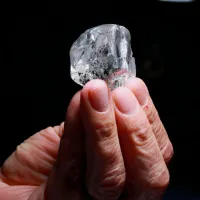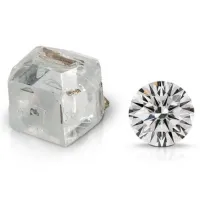Diamonds have been valued for centuries because they symbolize wealth, power and eternal love. However, the market now offers two main types of diamonds: natural diamonds and synthetic diamonds. Although they look similar to the naked eye, they are very different in their origin, properties and value. This blog will explore the key differences between natural and synthetic diamond, providing a clear understanding of each.
Table: Comparison of Natural and Synthetic Diamonds
| Feature | Natural Diamonds | Synthetic Diamonds |
| Origin | Formed naturally in the Earth’s mantle over billions of years. | Created in laboratories using advanced technological processes. |
| Formation Process | High pressure and temperature conditions deep within the Earth. | High-pressure, high-temperature (HPHT) or chemical vapor deposition (CVD) methods. |
| Time to Form | Billions of years. | A few weeks to a few months. |
| Inclusions | Contains natural inclusions and imperfections. | Typically has fewer inclusions; may contain metallic inclusions. |
| Value | Generally higher due to rarity and natural formation. | Usually lower due to availability and lower production costs. |
| Certification | Certified by gemological labs, like GIA, indicating natural origin. | Certified as lab-grown, with distinctions from natural diamonds. |
| Environmental Impact | Mining has a significant environmental footprint. | Less environmental impact, but still requires energy-intensive processes. |
| Ethical Concerns | Concerns over conflict diamonds and ethical mining practices. | Generally considered more ethical due to controlled production. |
| Color Variety | Occurs naturally in various colors, influenced by impurities. | Can be created in a controlled environment, offering a wide range of colors. |
Understanding Natural Diamonds

Natural diamonds are complex stars in a vast spectrum of color. Their color is caused by the presence of small amounts of chemical trace elements, which substitute elements and distort or alter the crystal structure of the diamond.
Natural diamonds are created deep within the Earth under impossible high heat and enormous pressure. It is a process that takes billions of years. The crystalline structure of carbon arranged in these diamonds make them. The first were found in India and mined over 3,000 years ago. The value in their rarity. Clear, colorless, with few inclusions are the most valuable diamonds.
Natural diamonds are often formed with a unique inclusion. Because these imperfections make every diamond unique, gemologists use them to trace its origins. Not only are they lovely, they are part of history, and the trouble involved in mining and shaping them adds to their value.
However, there are huge environmental and ethical issues surrounding mining natural diamonds. Extracting diamonds is harmful to habitats and polluting water. It has been criticized, too, for conflict diamonds, diamonds that help finance wars in certain parts of the world.
Understanding Synthetic Diamonds

Lab grown or artificial diamonds are created in managed laboratories. They are typically made by high pressure high temperature (HPHT) or chemical vapour deposition (CVD) methods. These follow natural diamond formation, except it only takes a few weeks or months.
Synthetic diamonds have one key benefit and that is their ethical production. They’re made in labs rather than contributing to conflicts, or unethical mining practices. They are also their less environmentally harmful than natural diamond mining and though their production still requires a huge amount of energy.
Fewer inclusions and greater variety of colors make synthetic diamonds so popular. Natural diamonds get their color from impurities as they formed, but lab created diamond color is also controllable, giving lab created diamonds more color options for buyers.
The advantages of these diamonds notwithstanding, synthetic diamonds tend to have less resale value. Since they can be made on demand, their rarity decreases. They’re not cheap, but they make a fine substitute if you want a diamond’s sparkle without the expensive price tag.
Conclusion
The choice between natural and synthetic diamond is ultimately down to personal preference, ethical considerations and budget. Natural diamond have historical and sentimental value, making them a timeless choice for many. In contrast, synthetic diamond offer a more durable and affordable alternative without compromising the beauty and durability that diamond are known for.
Both types of diamond have their own unique characteristics and appeal. Understanding the differences between them can help consumers make informed decisions that align with their values and desires.


2 comments
Hi my friend! I wish to say that this article is awesome, nice written and come with approximately all vital infos. I’d like to look extra posts like this .
thanks